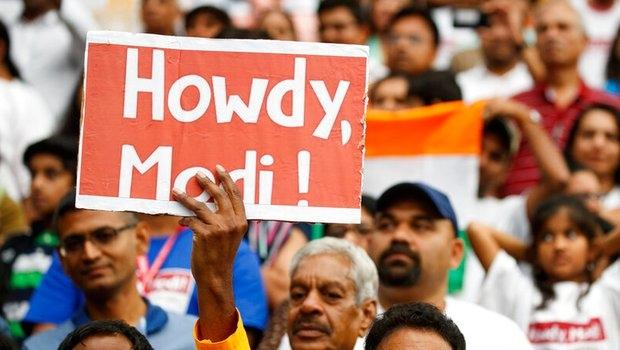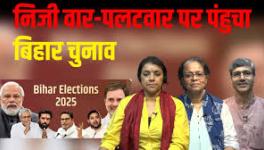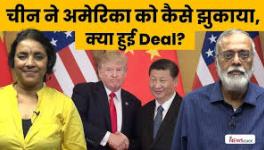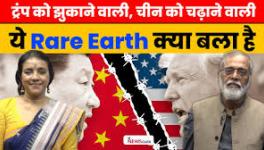Constructing a Hindu Ummah

The way the ‘Howdy, Modi’ extravaganza was planned, executed, and marketed, is bound to make one wonder if a Hindu ummah is under construction. At first glance, this characterisation appears comical, given that Islam, with which the idea of an ummah is associated, is Hindutva’s bête noire. Hindu ummah ought to be a contradiction in terms. Hinduism is doctrinally insular. In most cases, its rituals and meditational practices are personal. Unlike Christianity or Islam, it is also non-congregational.
Ummah is an Arabic word. It means ‘people’ or ‘community’. Its political connotation, however, is loaded. It conceives of a community of believers, meaning Muslims, who are spread across nations. They are expected to coalesce around the goal of propagating Islam, as doctrinally sanctioned in Islamic theology. Being a proselytising religion, Islam also has the notion of Dawat-e-Islam. It circuitously presupposes the superiority of Islam and, therefore, asks non-Muslims to join it.
Hinduism, on the other side, doctrinally discourages conversion. The only proselytising effort attempted within Hinduism was in the late 19th century by the Arya Samaj, when it introduced the ritual of shuddhi (purification), through which a converted Muslim or any non-Hindu could become a Hindu. But it was largely a non-starter. Shuddhi should also not be confused with the present ghar wapsi (return to the Hindu fold), which is nothing but political hooliganism by another name.
And yet, the possibility of a Hindu ummah is greater today than it ever was before: political Hinduism is active today in about 40 countries. In Western democracies, say, the United States (US), its visibility is causing ripples in its domestic politics and also among the other religionists. This could hardly have happened overnight. How, then, can one conceptualise its rise?
Some questions, therefore, are inescapable: What is the origin of the Hindu ummah, how has it evolved, what forces drive it, and what will its international fallout be? Does it prove Samuel Huntington right who talked about the ‘clash of civilisations’ in the post-Cold War world?
Before these questions are answered, some conceptual clarity is in order. One can do so by juxtaposing the concepts of Islamic and Hindu ummah. Two important differences between them immediately become clear. One, unlike Islamic ummah, the Hindu ummah is not doctrinally sanctioned (as noted above). And two, unlike the former, the Hindu ummah is remote controlled, from India.
It is alleged that Saudi Arabia, too, remote controls the Islamic ummah. Much as the Saudis would love for this to be true, it is not. At the macro level, Muslim countries barely show any unity, least of all under the leadership of Saudi Arabia. Leave alone the Shias, who constitute about 15% of the world’s 1.8 billion Muslims, even Sunnis are not necessarily pro-Saudi. And most Sunni countries watch with suspicion the unwelcome Wahhabi influence in their societies.
The 57-member Organisation of Islamic Cooperation (OIC) is barely taken seriously as an Islamic front, and even less so as a cohesive cluster in the classical ummah sense. If the latter has failed at the inter-governmental level, it has not fared any better at the societal level. Islamic ummah seems to be successful only in a form of ‘Islamic terrorism’ which is cross-national and dreams of a return to the glory of the Caliphate. But even ‘Islamic terrorism’ has multiple power centres.
Thus, it is clear that Islamic ummah exists only in name. Yet, we refer to it because we believe in some imaginary Islamic solidarity, a glue that brings it together. In the case of the Hindu ummah, Hindutva serves as this glue. Like the Islamic ummah, it too is not officially sponsored. But it is much more real than the Islamic ummah because it is semi-officially sponsored. The Rashtriya Swayamsevak Sangh (RSS) as its sponsor is now both the brain and brawn of India’s ruling Bharatiya Janata Party (BJP), which continues to expand its influence across the country.
To make the formulation clearer, let the entire period of independent India be divided into two phases: when BJP was not in power and when it was in power. We can see that the seeds of a Hindu ummah were sown in the first phase itself. It was as early as 1947, the year India gained independence, that emigrant RSS members opened branches in Kenya and Myanmar. But these efforts were rudimentary and probably not overseen by RSS headquarters in Nagpur.
The first clear guidance in this regard came in 1953 when RSS supremo Madhav Sadashiv Golwalkar exhorted RSS pracharaks (workers/promoters) to launch a “world mission to propagate the Hindu notion of the world as a single family” (emphasis added). In this call one can see the ground-laying ceremony of the Hindu ummah.
Soon, efforts were undertaken to enter Hindu communities in Nepal and Kenya, followed by similar activities in the United Kingdom. With the establishment in 1964 of the Vishwa Hindu Parishad (VHP), a militant Hindu affiliate of the RSS, the US started appearing more prominently on the RSS radar. In 1970 VHP began its operations there.
With the systematic push for Hindutva in the early eighties, through campaigns such as the Ekatmata Yagna (connotation: Hindus to think themselves as one soul), this overseas connection grew rapidly. In the beginning, it was difficult to distinguish between Indian-Americans in general and Hindu-Americans in particular. But with the growing dominance of the BJP as a political force in India, this distinction has increasingly become clear.
This organised thrust for Hindutva that we notice in several parts of the world today is what makes a Hindu ummah a real possibility. At present, the RSS is active in at least forty countries through organisations such as the Hindu Swayamsevak Sangh (HSS), the Overseas Friends of the BJP (OFBJP), the Hindu Education Foundation (HEF), the Vedic Foundation, the Hindu American Foundation, etc. With 15% of the world population being Hindu (1,100,000,000 people), this is an important political development with inevitable consequences for international relations.
It is not possible to do justice to the entire process of globalisation of Hindutva in this short essay, but an American case study can throw some light on some of the critical issues involved. In any case, when one talks about the Hindu diaspora, one generally means Hindus settled in the West, and that too primarily in the US. Modi’s two high-profile visits to America leave little doubt about this hypothesis.
America’s Hindu connection is old. In the early days, it was not the Hindu immigrants but Hindu philosophy that attracted many eminent Americans. In the writings of the transcendental philosopher Ralph Waldo Emerson (1803-82) one can see the influence of the notion of karma. Helena Blavatsky’s Theosophical Society (1875) had much to borrow from Hindu mystic philosophy. But it was Swami Vivekananda who hugely triggered American interest in Hinduism.
Vivekananda’s electrifying speech at Chicago’s World Parliament of Religions in 1893 impacted Americans so much that many joined his Vedanta Societies. In subsequent years, the writings of Rabindranath Tagore too had massive appeal because of his universalistic vision, which were themselves largely drawn from modern Hinduism.
The life and teachings of Mahatma Gandhi injected into American consciousness a profound vision about Hindu social ethics. With his spiritually-inspired political thought, encapsulated in his vision of non-violence as a weapon against oppression, Gandhi profoundly influenced at least three eminent Americans: civil rights leader Martin Luther King, Jr., Christian pacifist and activist AJ Muste, and folksinger-activist Joan Baez (of We Shall Overcome fame).
The current phase, however, is totally different. It is no longer the philosophy of Hinduism but Hindutva, or political Hinduism, which has assumed centre stage. This variety of Hinduism appeals little to Americans. Indeed, it is not meant to register their support. It aims at influencing American Hindus so as to make them serve as outstation cheerleaders of a particular political party in India that believes in Hindu nationalism.
It is common knowledge that America being a nation of immigrants will have all kinds of diaspora. Their respective mother countries do use them as lobbies to influence the American government in their favour. But the Hindu diaspora is a sectarian diaspora, not an Indian diaspora. As such, it contains a potential irritant for Indo-US relations, notwithstanding US President Donald Trump’s full-throated endorsement of Modi in the ‘Howdy, Modi’ event.
Representing a tiny number of Hindus in predominantly Christian America, it can expose the American Hindus to the distrust of the Christian majority. In response to the anti-Christian violence in India in the recent past, perpetrated by the same forces that dominate the Hindu diaspora in America, some American Christian organisations had called on the US State Department to take action. The fact that the latter almost routinely rebukes India for its shoddy record in terms of religious freedom must be factored in to understand this connection.
The other problem is more deep-seated and concerns the diminished influence of the Indian expatriate lobby in America. This lobby had played an important role during the signing of the Indo-US civil nuclear deal in 2008. Recall that when the importance of the Indian diaspora in America was first highlighted by Rajiv Gandhi, by coining the word ‘brain bank’ in place of ‘brain drain’, his reference was to the ‘Indian diaspora’, and not the ‘Hindu diaspora’. A recent study suggests that of the 966 Indian American organisations, 481 are religious organisations, and of these, 60% are Hindu.
It cannot be just coincidence, then, that with the coming to power of Narendra Modi in 2014, Muslim Indian-Americans have largely been expelled from the community. The Indian Embassy in Washington no longer organises an annual Eid reception. Both massive pro-Modi events, the first in Madison Square Garden in New York on September 28, 2014 and more recently in Houston, Texas, on September 23, 2019, were almost entirely dominated by rich Hindus. (Some Muslims Bohras attended the events as they support Modi in India, but they are an exception within the broader Indian Muslim community).
An ironic sidelight to the event was that although the Indian-origin Muslim comedian Hasan Minhaj was denied entry because of the digs he has taken at Modi on his Netflix show Patriot Act, he was featured in the event. Standing outside the stadium, Minhaj watched a livestream of the show and reported the irony of seeing “his own face up on the jumbotron as one of the Indian-Americans being honoured for their contribution to the arts.”
Not all Hindus in America have turned Hindutva enthusiasts, but those who have are more vocal and organised. Pieter Friedrich, a well-known American specialist on South Asian communities says: “Those who oppose Modi often follow elections in India with great interest, and maybe even talk or write about them, but do little beyond. Those who support Modi host [or] organise rallies, training camps, and campaign events. While one side alleges that Modi staged a pogrom, thousands of volunteers from the other side return to India to physically canvas for his political party.”
Let all Hindu-Americans, particularly the types that throng ‘Howdy, Modi’ events, be reminded that they have sworn to the US government on becoming American citizens that, “I hereby declare, on oath, that I absolutely and entirely renounce and abjure all allegiance and fidelity to any foreign prince, potentate, state, or sovereignty, of whom or which I have heretofore been a subject or citizen; that I will support and defend the Constitution and laws of the United States of America.”
They may also be reminded that America has a violent history of hostility against new immigrants; for example, against the Japanese-Americans during the Second World War. Only a decade prior to that, the Americans had chanted against “the menacing spread of Hindus”. It is elementary in international politics that there is no permanent friend or foe; today’s friend-India can be tomorrow’s enemy-India.
Of all people, Trump is probably least dependable in this regard. Today he may go to the ridiculous extent of calling Modi “the father of India”, but tomorrow this same Trump may say with equal aplomb that Imran is the father of Pakistan, and hence that Modi and Imran are cousins’ He will then step in with his masterly real-estate business skills to divide the real estate called Kashmir between the two cousins.
Anyone who has even elementary understanding of how the US presidential election works would have noted that it was Trump who played his cards better than Modi. By sharing the podium with Modi in front of enthralled Modi fans, Trump was trying to poach into the pro-Democratic Indian-American community to further his 2020 reelection prospects. Texas has 38 votes in the Electoral College, next only to California, which has 55. Trump cannot afford to lose Texas, which, though traditionally Republican, has of late shown a tendency of drifting towards the Democrats. In a close contest, the Hindu-American support will matter.
Let me conclude this essay with a lament. As soon as one becomes a religious fanatic, he stops distinguishing between right and wrong because that faculty is no longer in his possession. This is true of all fanatics, Hindu, Muslim, Christian or Buddhist. That is the risk in the expansion of the Hindu ummah, as was the case with the Islamic ummah, which degenerated into terrorism.
It is chilling to note the expanded space that religion is occupying these days in our lives across every continent. Even our social relationships are facing a crisis of confidence because of the phenomenon. Although most social media posts are garbage, some are quotable. Let me recall one: “Want to convert a friend into an enemy? Discuss politics. If that fails, try religion.”
Postscript: This year, India is celebrating the 150th anniversary of Mahatma Gandhi enthusiastically. It is instructive to know what the Mahatma had to say about the Indian diaspora. Though it was smaller at the time—limited almost entirely to Ceylon, Malay and the West Indies, where Indian indentured labourers had settled—his thoughts remain relevant today. Addressing a congregation of Indian Tamils in Colombo on 25 November 1927, Gandhi had said, “Since you are earning your bread in this beautiful island, I would ask you to live as sugar lives in milk. Even as a cup of milk which is full up to the brim does not overflow when sugar is gently added to it, the sugar accommodating itself in the milk and enriching its taste, in the same way, I would like you to live in this island so as not to become interlopers and so as to enrich the life of the people in whose midst you may be living.”
Partha S Ghosh is a senior fellow at the Institute of Social Sciences. Views are personal.
Get the latest reports & analysis with people's perspective on Protests, movements & deep analytical videos, discussions of the current affairs in your Telegram app. Subscribe to NewsClick's Telegram channel & get Real-Time updates on stories, as they get published on our website.














